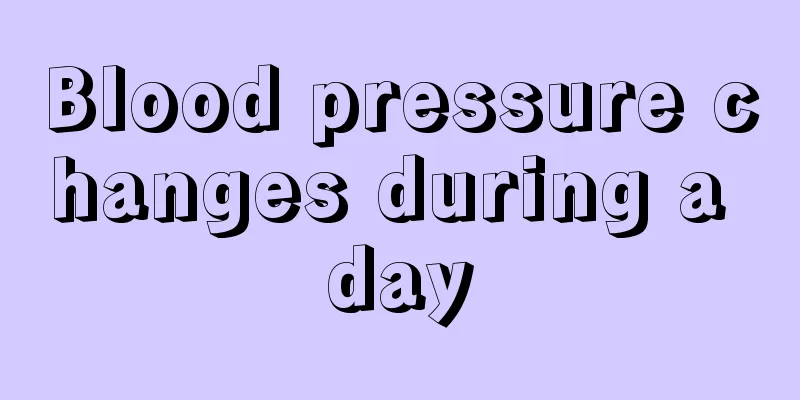Blood pressure changes during a day

|
Blood pressure is an important health indicator of the human body. Of course, blood pressure will also change according to people's physical condition, and this change also follows certain rules. If your blood pressure changes regularly, it means you are relatively healthy. However, if your blood pressure changes irregularly, you need to go to the hospital for examination in time. Next, I will introduce to you some knowledge about the changing patterns of blood pressure! 1. Daily changes in blood pressure Blood pressure changes rhythmically under physiological conditions. The typical rhythmic changes of blood pressure show "double peaks and one valley", that is, blood pressure gradually rises after waking up in the morning, with the first peak occurring around 8 to 10 am, after which blood pressure tends to stabilize, with the second peak occurring around 3 to 5 pm; after falling asleep at night, blood pressure gradually decreases, reaching the lowest level between 3 and 4 am. The above is a general rule. In fact, everyone's blood pressure fluctuations are unique. Some people have particularly high blood pressure when they wake up in the early morning, while others have high blood pressure in the evening. Generally speaking, blood pressure during the day is higher than blood pressure at night, and this blood pressure curve is called dipper-shaped blood pressure. To be more precise, dipper blood pressure refers to a 10% to 20% drop in nighttime blood pressure compared to daytime blood pressure. If the nighttime blood pressure drops by less than 10%, it is a non-dipper; if the nighttime blood pressure does not drop but rises, it is a reverse dipper; if the nighttime blood pressure drops by more than 20%, it is an extreme dipper. There are more non-dippers in hypertensive patients, and the proportion of extreme dippers is also higher in elderly patients. 2. Standards and causes of high blood pressure Blood pressure measurements are affected by many factors, such as emotional excitement, tension, exercise, etc. If the standard measurement method is used under quiet and sober conditions, and the blood pressure values on at least three different days reach or exceed systolic pressure 140 mmHg and/or diastolic pressure 90 mmHg, it can be considered that hypertension exists. If only the systolic blood pressure reaches the standard, it is called isolated systolic hypertension. The vast majority of hypertension is primary hypertension, and about 5% is secondary to other diseases, called secondary or symptomatic hypertension, such as chronic nephritis. Hypertension is an important risk factor for atherosclerosis and coronary heart disease, and is also an important cause of heart failure. 3. Standards and causes of lowered blood pressure Any blood pressure below 90/60 mmHg is called hypotension. Sustained hypotension is often seen in serious conditions such as shock, myocardial infarction, and acute cardiac tamponade. Hypotension may also have physical reasons. The patient reports that his blood pressure has always been low. The patient's oral mucosa is partially pale. When the heart contracts and relaxes, the edges of the pale area change from red to white regularly, which is the capillary pulsation sign. |
<<: The impact of temperature on blood pressure
>>: The relationship between weight and blood pressure
Recommend
The correct time to use eye mask
Many people use eye masks to make their eyes look...
Six tips for nourishing the kidneys in summer
How to nourish the kidneys in summer? The kidneys...
I have small pimples on my neck. What should I pay attention to in my diet?
There are many factors that cause small pimples o...
How much weight gain is normal during 5 and a half months of pregnancy?
There will be many changes in women after they be...
Is the permanent hair removal method real?
In recent years, many beauty salons have launched...
What is secondary liver cancer
Secondary liver cancer is also called metastatic ...
How much does targeted treatment for lung cancer cost per month? How effective is targeted treatment for lung cancer?
Lung cancer is currently a relatively common mali...
What are the ways to make your skin whiter and softer?
Fair skin is not only a fashion, but also a sourc...
How long does it take for wrist ligament injury to heal
Many dancers will do stretching exercises for abo...
The relationship between Helicobacter pylori and gastric cancer
Helicobacter pylori is one of the main causes of ...
Two great treasures for health preservation that both men and women need
As the saying goes, "Men rely on food and wo...
What are the special early symptoms of hepatic ascites
In fact, ascites is a common liver disease. Don’t...
What are the benefits of lotus seed pod tea
Lotus seed pods are also called lotus pods. They ...
You should choose the method of treating lymphoma according to your own characteristics
Experts say that the best way to treat lymphoma i...
Top six longevity habits
Daily habits may be more important than genes for...









